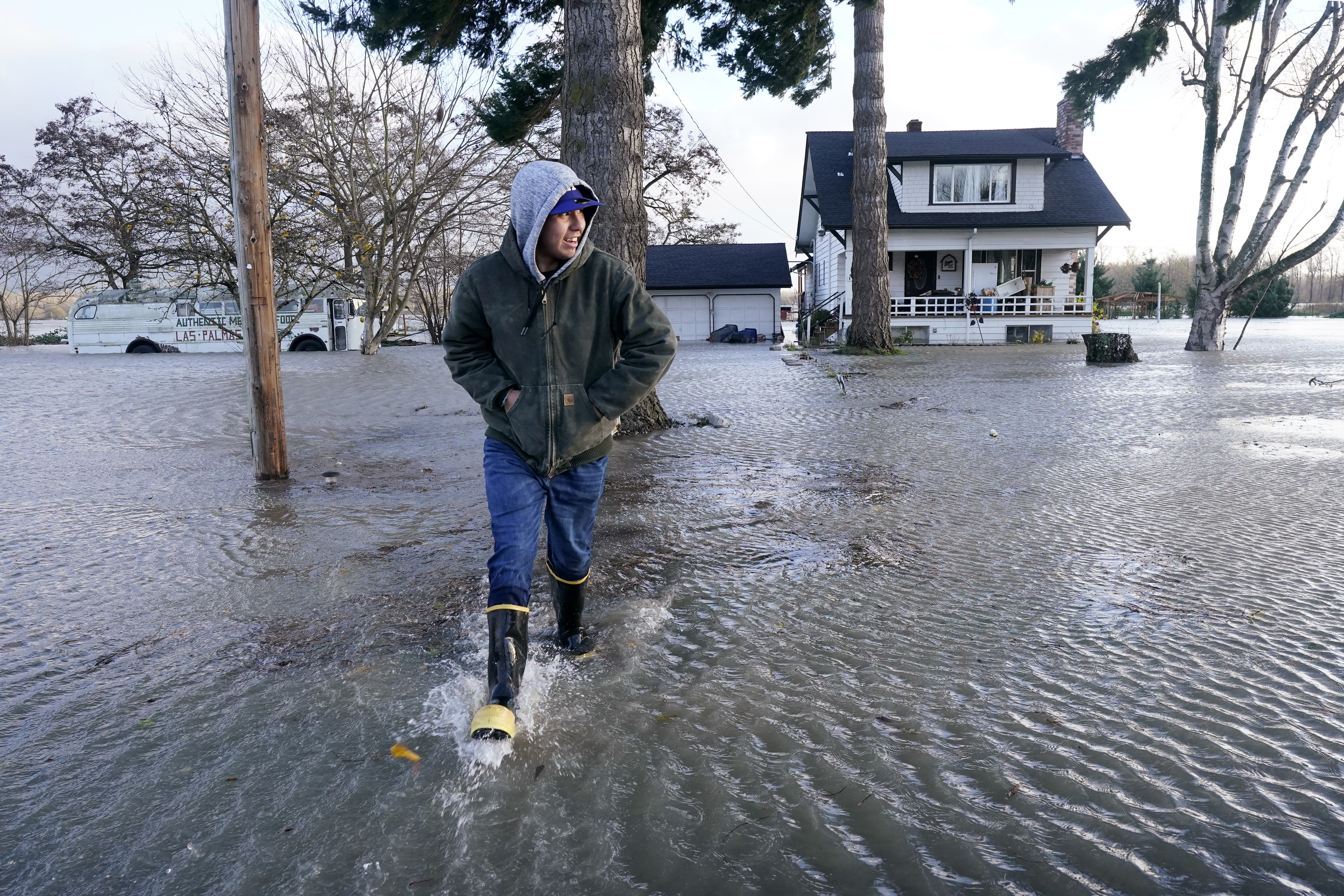
Benjamin Lopez steps from floodwater surrounding his parents home Monday, Nov. 15, 2021, in Sedro-Woolley, Wash. The heavy rainfall of recent days brought major flooding of the Skagit River.
Elaine Thompson / AP
More people were urged to leave their homes Tuesday and officials in a small Washington city near the Canada border are calling the damage devastating after a storm that dumped rain for days caused flooding and mudslides.
Sumas city officials said Tuesday on Facebook that hundreds of people had been evacuated and they estimated that 75% of homes had water damage in a soaking that reminded people of Western Washington’s record, severe flooding in November 1990 when two people died and there were more than 2,000 evacuations.
"These families and businesses need our prayers and support as we start the process of cleanup and rebuilding over the next few days," the post said.
Additionally, six railroad cars that had been sitting on tracks in a BNSF rail yard in Sumas derailed in the flooding Tuesday, according to Lena Kent, BNSF general director of public affairs. Trains in that location and others won't be running until water recedes and debris is removed and tracks are inspected, she said.
Just over the border, residents in about 1,100 rural homes in Abbotsford, British Columbia were told to evacuate Tuesday as waterways started to rise quickly. Police said they understood many of the affected properties are dairy farms or house other livestock, but said the situation was changing rapidly and residents must leave.
In the northern Washington city of Ferndale, officials on Tuesday urged people in homes and businesses to evacuate in an area near the rising Nooksack River, saying it had potential to breach the levee.
Road crews on Tuesday managed to partially reopen the West Coast’s main north-south Interstate 5 near Bellingham, a city south of Ferndale, following its complete closure overnight. But the highway’s northbound lanes were still closed in the area.
The rains were caused by an atmospheric river — a huge plume of moisture extending over the Pacific and into Washington and Oregon.
It was the second major widespread flood event in the northwest part of the state in less than two years after a similar storm in early 2020, and climate change is fueling more powerful and frequent severe weather, Whatcom County officials told the newspaper.
At the height of the storm, more than 158,000 electrical customers in western Washington on Monday had no power and schools in and around the city of Bellingham were closed on Tuesday for the second day in a row. Nearly 50,000 Washington state electrical customers remained without power on Tuesday, officials said.
Northeast of Bellingham in the Everson area, authorities said one person was still missing Tuesday after being seen in floodwaters clinging to a tree.
And a motorist in Bellingham was seriously injured Monday on Interstate 5 when a tree fell on a vehicle. Monday winds reached speeds of 60 mph (96 kph), including one gust of 58 mph (93 kph) at Seattle-Tacoma International Airport.
Conditions were drier Tuesday but the National Weather Service issued flood warnings for several rivers around Western Washington. The National Weather Service also said there was good news in that south of Bellingham, the Skagit River at Mount Vernon would crest at a level below previous estimates and potentially cause less damage.
Up the Skagit River from Mount Vernon in the town of Hamilton, floodwaters surrounded homes while vehicles were packed into a parking lot outside a church that served as a Red Cross evacuation site.
Skagit County officials compared the flood to severe flooding in 2009, when the Skagit and Samish rivers overflowed and caused damage to homes, farms and infrastructure.
Gov. Jay Inslee declared a severe weather state of emergency in 14 counties and said the state Emergency Management Division, with support from the Washington National Guard, would coordinate the response.
Bellingham’s record rainfall on Sunday totaled 2.78 inches, crushing the prior daily record from 1998 of 0.88 inches, according to the National Weather Service. Another 1.89 inches poured down on Bellingham on Monday.
West of Seattle on the Olympic Peninsula, several highways were partially closed and the U.S. Coast Guard helped local authorities evacuate about 10 people near the town of Forks. In nearby Quillayute, a daily record rainfall of 4.01 inches was set on Monday.